#Sarhad Village
Photo

We are south of Bozai Gumbaz, going back to Sarhad. This is the first kyrgyz village you encounter in the way to Little Pamir. A smoky atmosphere welcomes us. Badakhshan, Afghanistan.
Taken on August 18, 2016
PayPal Donation: [email protected]
#Silvia Alessi#Bozai Gumbaz#Sarhad#Kyrgyz#Little Pamir#Pamir#smoky atmosphere#Wakhan#Badakhshan#Wakhan Corridor#Afghanistan#2016
32 notes
·
View notes
Text
Guide the Rann Utsav Tent City – All You Need to Know
Gujarat Tourism is one of the forceful the travel industry advancement body, attempting to elevate inbound traveler stream to Gujarat, and gratitude to then CM Sri. Narendra Modi's vision, once the bluntest and abandoned spot called Dhordo White Rann has been changed into one of the most happening vacationer goals of Gujarat.
The tent city made close to the Dhordo Village is one ideal administration of an impermanent human settlement. The AC and non-AC tents are furnished with every single imaginable pleasantry that one can think and request. Room radiators, the nonstop supply of warm water in a desert, shopping complex for every one of your needs, display focus, experience one and two humongous feasting corridors – no necessity is left unanswered here – Book Rann Utsav Tent

The brilliantly organized tent city at Dhordo furnishes you with each conceivable convenience that you can consider. Room-radiators and climate control systems to all day, every day long periods of high temp water supply in the desert, you will enjoy safety and security when looked with the outrageous temperatures of Kutch. No detail has been left unaddressed here, no prerequisite is unanswered. Aside from the 400 tents, the 'city' has a commercial center, a show focus, an undertaking zone, and two huge eating corridors.
The Swiss and the extravagance tents at the scene, homestays in the close by towns, ethnic cabins worked for urban townspeople, and obviously, a wide scope of lodgings. A decent number of resorts have come up lately and the absolute best great choices are Shaam-E-Sarhad Village Resort and the Gateway to Rann Resort.
Where to Stay at Rann Utsav
Lodging is accessible at the scene by method for Swiss tents and Luxury tents. The close-by towns likewise offer spots to remain. These are ethnic cottages called Bunga worked to suit any urban traveler. GTDC inns are additionally very pleasant. There are a few retreats at Dhordo and in the event that you need to live in the nearest conceivable vicinity to the Tent City, at that point 'Entryway to Rann' is a hotel you'll want to set up at - Rann Utsav tent booking
You will begin losing the feeling of a time when you are at Rann Utsav, there are various exercises to keep you occupied and most significant engaged be it star brushing, neighborhood move, enchantment appears, visit white rann, Indo-Pak Border visit, Bhuj Local Sightseeing, Mandavi and a lot more alternatives to totally douse yourself in Kutch.
Source: https://www.rannutsavindia.com/gallery/
The Rann Utsav 2019 will be the one that will fulfill your taste buds more than what you may have thought of. It has savoring and delightful Kutchi cooking styles and treats. Book with us Rann Utsav 2018-2019 and we guarantee you that you will be furnished with finger-licking plans. Other sustenance slows down are likewise accessible to fend off the appetite during odd occasions. Tea and espresso are made accessible as that is the most usually requested beverage for the duration of the day.
0 notes
Photo


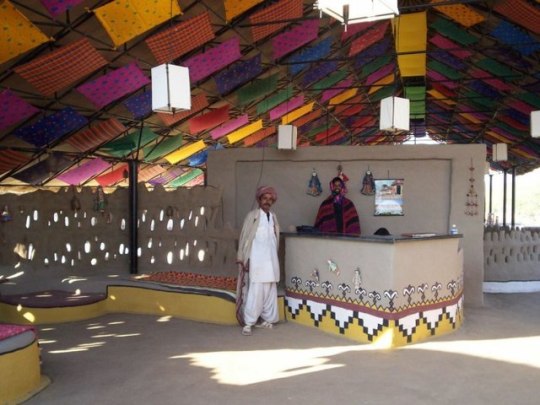
Project name:
Hunnarshala campus
Client name:
Hunnarshala foundation
Location:
Bhuj
The Hunnarshala campus building was completely an evolving structure itself. It was designed with a sole reason to demonstrate all the alternative constructional technologies they excel or research in construction practices such as stabilized rammed earth construction, Space frame systems, Thatch installation, wood roof understructures & CSEB.
It was designed to create a platform for the artisans and professionals to support their curiosity to learn and share the knowledge. The whole project was treated like an experiment to adapt the techniques they have researched or excelled and check the performance of the same. The material from the old building was recycled and used in the new building.
Based in Kutch, Hunnarshala is a not-for-profit architectural organisation that works closely with local communities. Its objectives are three-fold: to empower local communities with skills and knowledge essential to building their own habitats; educate rural artisans in mastering carpentry and masonry skills; and research of sustainable building materials.
Their most popular community project – the Shaam-e-Sarhad village resort in the north of Bhuj has made its mark as a tourist attraction as well as an architectural achievement. But the organisation’s ideals and philosophies are best exemplified at its own campus which is built using natural and waste material in collaboration with several master artisans and architects.
At the campus, the organisation incubates firms that specialise in joinery, thatch making, rammed earth construction, space frame manufacturing etc. and provide the artisans support right from formal training and design to administrative, financial and legal matters.
The incubation cell has been a successful launch pad and confidence booster for many rural artisans.
The word Hunnarshala derives its origins from Hunnar which means ‘arts’ in Urdu and ‘skill’ in Hindi; shala means ‘school’. Hunnarshala was conceived in the wake of the 2001 Bhuj earthquake when houses made of concrete collapsed, killing many and rendering several others homeless. The earthquake brought some surprising revelations to the fore: Bhungas (circular, thatch-roofed huts) in the Banni region survived the earthquake without any casualties proving that houses built with traditional materials were stronger than modern buildings and second – local artisans were actually quite proficient in building their own habitats.
Taking notes from the master craftsmen of Banni and their community-based approach, Hunnarshala helped rebuild 1200 houses in the region. “We have since sponsored research and helped three state governments, Uttarakhand, Gujarat and Bihar develop technical guidelines to build modern buildings with traditional materials like stone, earth and bamboo respectively”, relates Sandeep Virmani, Vice Chairperson of Hunnarshala.
Abroad, the organisation was instrumental in helping 3700 Indonesian families build disaster safe and eco-friendly houses after the devastating 2004 Tsunami. In India, it stepped in to rebuild habitats for victims of the 2005 earthquake in Jammu & Kashmir and the 2008 floods in Bihar.
The organisation is currently in the throes of a massive operation to make Bhuj slum free in five years. Together with the municipality they have helped 500 slum dwellers build sustainable houses using earth and construction waste while also managing their own water supply and recycling sewerage.
Sandeep links the flagrant and irresponsible construction we see around to the breakdown of communities. He says, “The understanding of appropriate construction is not difficult to acquire or understand. It is the feeling of caring for one another and the moral accountability that communities ensure that builds safe and beautiful buildings.”
Text By Christabelle Athaide
Photographs Courtesy Hunnarshala Foundation
http://www.hunnarshala.org/shaam-e-sarhad-village-resort.html#
http://www.achr.net - The Asian Coalition for Housing Rights is a regional network of grassroots community organizations, NGO's and professionals actively involved with urban poor development processes in Asian cities.
The coalition is action-orientated, highly decentralised, and aims to provide an alternative model of urban development based on Asian realities and experiences.
0 notes
Photo

Gujarat Tour from Mumbai
Colours of Gujarat is a 13 days in-depth cultural tour starts and ends in Mumbai with 10 other destinations to explore. The tour includes 12 nights accommodation, sightseeing, all transfers and 12 breakfasts at the hotels.
https://www.holidaysat.com/packages/private-luxury-colours-of-gujarat-tour-package
Travel Itinerary
Day 1: Fly to Bhuj via Mumbai (Bombay)
Fly to Bhuj via Mumbai.
Day 2: Bhuj
Arrive and transfer to Shaam-e-Sarhad Village Resort for 3 nights.
Day 3: Bhuj
Visit the walled city of Bhuj where highlights include a visit to the Aina Mahal Palace (the Palace of Mirrors). The tower, which featured in the Bollywood film 'Lagaan' can be seen from the outside but cannot be climbed as the building was damaged in a 2001 earthquake.
Day 4: Banni villages
Take a full-day tour of the Banni villages and the salt flats to gain an insight into the daily life of the artisans whose work is integral to the culture of the region. Traditions such as needlework and textile arts are preserved by almost every community in the region.
Day 5: Gondal
Drive to the small royal town of Gondal, located on the banks of the River Gondali in Gujarat. Stay at the Orchard Palace hotel for 2 nights.
Day 6: Junagadh
Take a full-day tour of the magnificent Junagadh fort which lies at the foot of the Girnar Hill. The main feature is the Uparkot fort (upper fort), a sombre fortress that rises from a hill with old palaces, Buddhist caves, stepwells, moats and huge battlemented walls.
Day 7: Sasan Gir National Park
Travel to Sasan Gir National Park and spend 2 nights at the Lion Safari Camp. The Park is made up of mostly forest area with rocky hills and deep valleys with numerous rivers and streams. It is also Asia's last natural home of the Asiatic lion (Panthera Leo Lersica).
Day 8: Sasan Gir National Park
Explore Sasan Gir National Park in the morning and afternoon. The chances of spotting the Asiatic Lion are very good and the park is also home to a large Leopard population. Spotted gazelles, wild boar, wolves, hyenas and an array of birdlife also reside here.
Day 9: Bhavnagar
Drive to Bhavnagar which is still an important trading post for cotton goods manufactured in Gujarat and. Stay at the large heritage Nilambagh Palace hotel for 2 nights
Day 10: Shatrunjaya temple complex
Visit the Jain temple complex of Palitana, set among the Shatrunjaya hills, which consists of 863 intricately carved marble shrines. Palitana is widely considered to be one of the most sacred sights for Jains and was once the capital of the princely state of the Gohil Rajput clan.
Day 11: Ahmedabad
Drive to Ahmedabad and stay 2 nights at the House of MG. In the evening walk around the historic city founded by the then King of Gujarat. It is still possible to see the gates and walls of the original fortifications, and some striking examples of Indian Islamic architecture.
Day 12: Modhera
Visit the sun temple at Modhera where the exterior is intricately carved and the building designed so that the sun's rays illuminate the sanctum at dawn during the time of the equinoxes. In front of the temple is a colossal tank, which was once known as Surya Kund or Rama Kund.
Day 13: Departure via Mumbai
Take the morning flight to your next destination.
#Gujarat Tour Packages#Gujarat Tours India#Gujarat Holiday Packages#Gujarat Tourism Packages#Gujarat Tours 2019#Gujarat India Tours#HolidaysAt
0 notes
Text
Amritsar- The Holy Sikh City
This city for me is one of the brightest memories of Indian trips. The reasons are First great for the budget. Second, cultural aspect, unique atmosphere and different religion compare to the rest of the country. Third, political aspect, the border between Pakistan and India is nearby so every day you can witness interesting performance at Wagah border point.
So let’s just go for a very beautiful journey of this very beautiful city.
About the city:
Amritsar is located in Punjab state, near Indian-Pakistani border, in the north-west of the country. Amritsar is a holy city for the Sikhs. Sikhism was founded in the Punjab area in the 16th century by Guru Nanak. It’s monotheistic religion based on Guru Nanak’s teachings. Now a days there are about 20 million Sikhs in the world, it is the 8th biggest religion.
This city is home to the Harmandir Sahib (commonly known as the Golden Temple). In the history of the Muslim League War on the Hindus and Sikhs of the Punjab in 1947, Amritsar occupies an outstanding position. It was in this city, along with Lahore, though with an intensity even greater than in the latter town, that the most sustained war, lasting for over five months was waged on the Hindus and Sikhs.
During my trip i want you to accompany me for the following three very famous destinations.
Ø WAGAH BORDER
Ø The Great Golden Temple.
Ø The Jallianwala Bagh
I reached Amritsar morning 8 o’clock followed by an overnight journey from Delhi. My hotel named Hong Kong Inn was precooked from Dubai, and i can recommend it to my fellows.
After check-in I took shower and headed my way to Wagaah border with Mr. Avtaar Singh (My pre-booked taxi’ driver) He was a very nice man , aging almost 55-60 years old and an amazing source to know the history and all hidden stories of the city .
In our way my first priority was to look for a Desi Dhaba so I can enjoy the original Punjab’ rich taste As Avtar ji was a local from Phagwara (A nearby village) was aware of all the highway side good Dhabas .
After a 30 Km run, we stopped at “Lucky Da Dhaba”. This place was crowded which assured me about the quality of food. And I had the world’s best “ Lassi” with Aloo prantha . The serving is enough to keep you full for long time as parantha is coming with a number of side dishes and a butter cube. See here:

So after heaving this heavy meal around 1 o'clock , I literally wanted to sleep but the greenery on the way and that smell of soil of the Punjab did not allow me to do so . I was enjoying the scenic beauty both side of the road from the window of my car.
As it was the Month of March the whole land was covered with a combination of yellow and green color of the “Sarso crop”. Which will give you a feel of acctuall incredible, productive & beautiful India. See through my below frame.
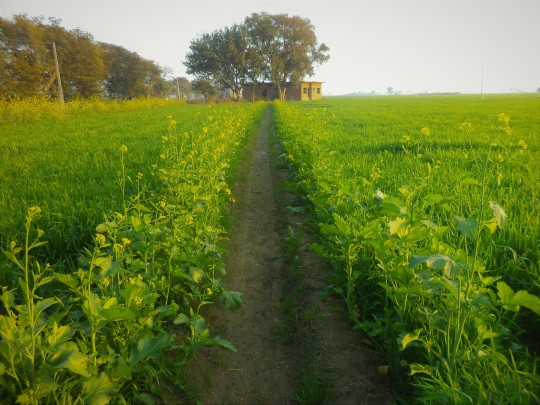
It took almost one hour to reach The Wagah Border.
On the entrance of Wagah border, there is a very interesting restaurant named “Sarhad Choubara”. Pakistani and Indian food is served at this Punjab style brick building near the border. So if you guys are planning this route, do try the amazing “ lehsuni paneer “with “makka roti”, and thank me later for this :P. Let me share some of the captures with you :
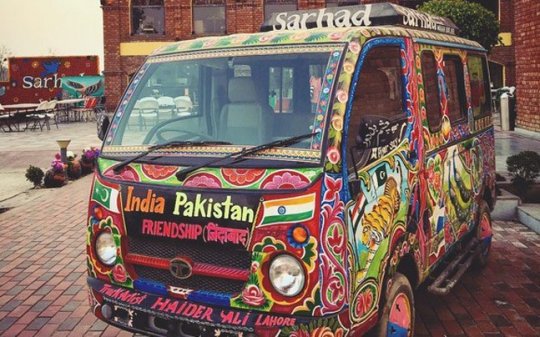



Before we head towards Wagah Border ceremony, let’s just do a short round up for the history behind it:
Background at the Wagah Border:
In 1947 the immensely controversial ‘Radcliffe Line’ was drawn between India and Pakistan as the result of India’s independence from British control. The border sliced through densely populated areas instead of being drawn between them, leading to an unfortunate series of bloody border conflicts.
One of the most affected areas was Wagah, a largely populated village now divided into two, and in some extreme cases, even homes were split by the border. Mass departures occurred during the partition of the border, resulting in conflict and significant bloodshed. Today the eastern half of the village remains in the India while the western half belongs to Pakistan and every evening a symbolic border closing ceremony take place at the gates between the two states on Grand Trunk Road, which was once the only link between the two countries.
So after finishing the photo session and the Yummy food of Sarhad , we headed towards the Border gate , it’s not far from there . Within 15 minutes we entered in the gate of Wagah village.
Car parking is concentrated to particular areas. So we parked our can. One thing I need to inform you on order to avoid the inconvenience that No covered bags (including ladies purses & handbags) are allowed inside the visitor areas. However, border personnel allow carrying of clear plastic bags with few snacks, water, children's food etc.
As there is no sign boards for this information and” I have to walk again all the way from security check to keep my bag in car “
There are two types of sitting areas VIP Sitting areas & General Sitting areas.
VIP seating - closest to the gates and requires a special pass which can be made from the BSF station near the Amritsar bypass road a couple of days in advance.
General seating - tends to get very crowded and congested during rush days. Depending on gender distribution two of these areas (north and south of the road) may be assigned accordingly
As I have planned it from a long time back, I got this special pass from BSF . Visitors from both sexes are kept together in the same area after going through the separated security lines.
As I get in the main area there was sitting arrangements on the both side of the road, patriotic song were playing on a high volume. Soldiers were receiving the visitors and helping them to sit both side of the road. It was such a proud feeling that we are belonging of this great country.
It left me surprised to see the craze out there!!
People were dancing out of excitement and happiness, to see this fun I decided to move and sit on the common sitting area so I can also dive in the ocean of that excitement.
As the sun started to set, Wagah Border comes alive with an incredible zeal and an unmistakable nationalist energy on both sides. The show started off with the playing of patriotic songs and remembering the brave soldiers who laid down their lives for the country. The crowd cheers on by calling out ‘Jai Hind’ and ‘Vande Mataram’, reciprocated with cries of ‘Pakistan Zindabad’ from the opposite side.
This ceremony starts with a stiff-marching parade by the soldiers from both the sides. Soon after, the heavy gates at the Wagah Border are flung open; the soldiers approach each other by exchange fierce looks, give out mimicked threats, and show anger. At this point the noise in the open-air theatre transforms into pin drop silence. After this two flags are lowered and carefully folded before the gates close once more and the ceremony is complete.
Here I want to witness this feeling through my Photo Gallery Down.
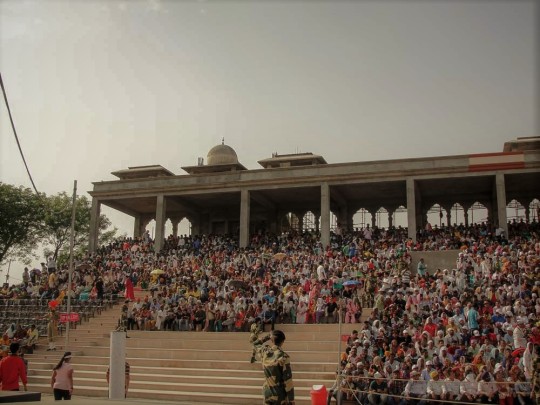

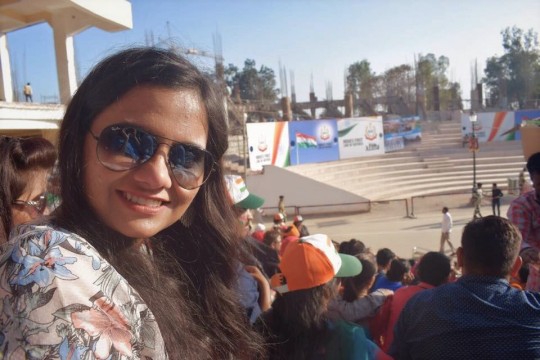


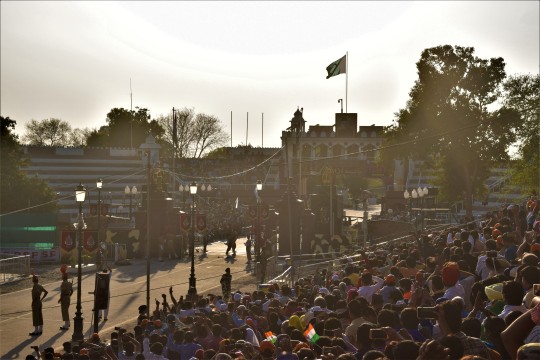
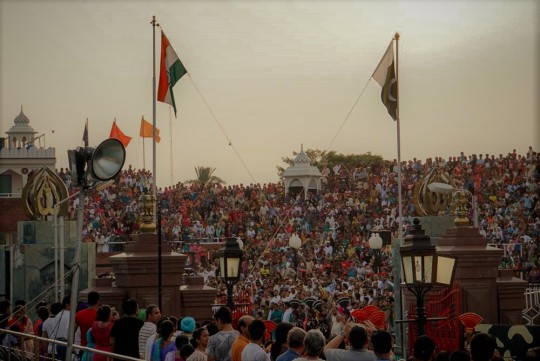

There is a Milestone near Exit gate for Lahore!! And I did not miss this chance and took this capture.

That’s how I was finished with the ceremony and rushed to my hotel so I can head towards my next day’s plans. I was quite tired so as soon as I reached my hotel I went to sleep so I can wake up early next day.
Day 2
I was very excited about my next destinations for the day.
You simply can’t miss visiting the Golden Temple in Amritsar if you want to travel India and feel the beauty and essence of this country.
So my first destination for the day was Golden Temple. Its official name is actually Harmandir Sahib but the Golden Temple name is commonly used by tourists due to the temple being covered in real gold.
My planning was to spent quite good time here so I left early from the hotel and, This Holy place was not so far from my hotel, within 15 minutes’ drive I was there.
After a walk of 10 Minutes , I was there in front of the Great Golden temple , and trust me it is simply one of the most beautiful sights I’ve seen in my life.

Just Wow! My first glimpse of the beautiful Golden Temple!
The Golden Temple is open to everyone but all visitors must remove their shoes, wash their hands and feet and cover their heads before entering. If you don’t have a scarf there are little orange headscarves that you can borrow at the entrance and the water you walk through to cleanse your feet is lovely and refreshing on a hot day!
The Golden Temple is the jewel of a much bigger complex called Harmandir Sahib that contains more shrines and monuments, a museum, dining hall (langar) and pilgrims’ accommodation.
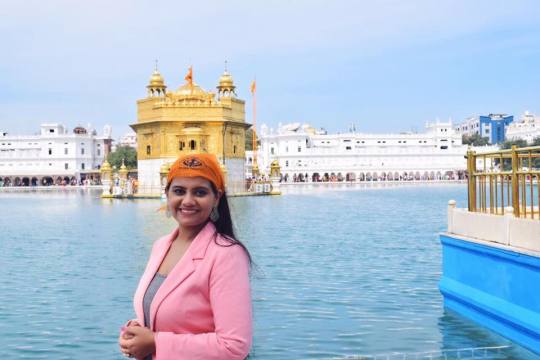
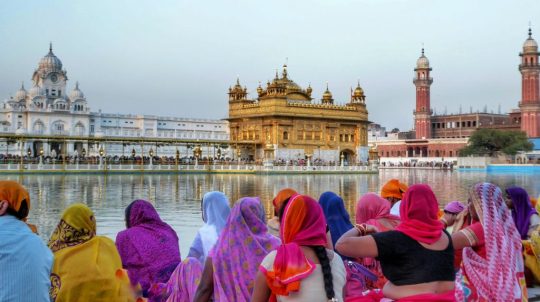
It has four entrances in the North, East, South and west, to demonstrate that people from all four corners of the earth are welcome here.
The main building of the Golden Temple is surrounded by a lake, known as Amrit Sarovar .People of all religions come here in huge numbers to offer prayers and take a dip in this supposedly holy lake.
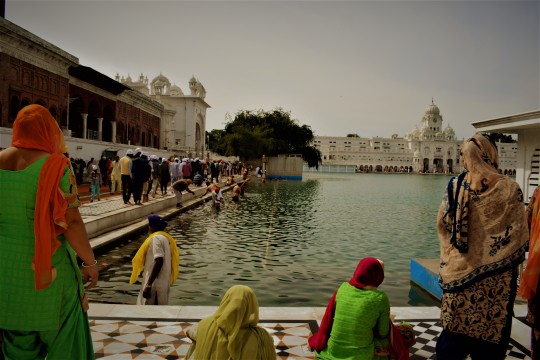
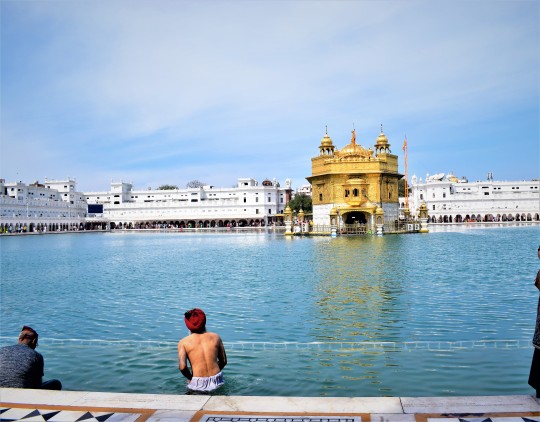
This pond has a number of fishes inside it, and these are a big excitement to children (and to adults such as myself) when they are seen. And you will not believe they are not scared of humans, they come closer to get their offerings.

Inside there is asmall temple the Guru Granth Sahib, the Sikh holy book, takes pride of place while priests and musicians chant continuously and quite mesmerizingly.
Due to the small space devotees have to move through quite quickly. Photography was prohibited inside the main temple.
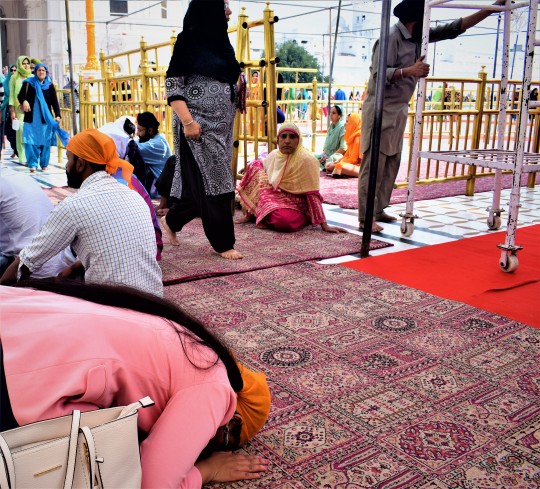
Another one of the things I loved and found really inspiring about the Golden Temple was the way in which an army of volunteers keeps the place sparkling clean and serves up to 100,000 vegetarian meals free every day, all day and to everyone who visits.

The local devotees doesn’t even allowed me to leave without having the langar bhoj, And trust me the taste of that thali was so yummy and very satisfactory.
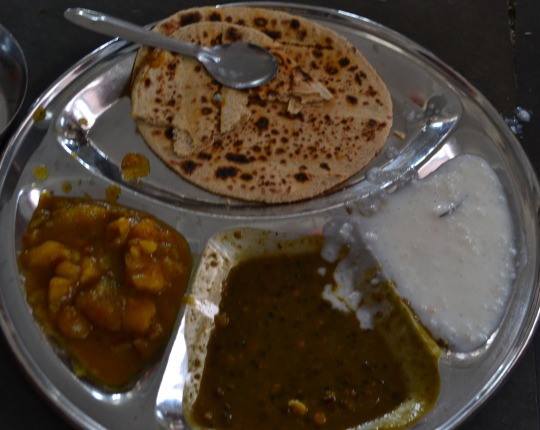
There is a ceremony every morning and night when the book is moved from the temple and then put to bed in the “Akal Takhat” which also contains a collection of sacred Sikh weapons. The ceremony is really interesting to watch, it happens at 5 am and 9.40 pm in winter or at 4 am and 10.30 pm in summer. But I was late in the morning and could not stay long as I have to catch my flight. But next time whenever I visit this amazing lace I’ll make sure I’ll attend the ceremony and will write you guys the experience.
So like this I have covered this beautiful place by enjoying and feeling the every bit of it. And I managed to click some of the other corners of this shrine.




There is a small market on the walk way to Golden temple with a pure essence of Punjab .
You can find the pair of lovely juttis or that beautiful Patiala salwar kurti easily girls !!
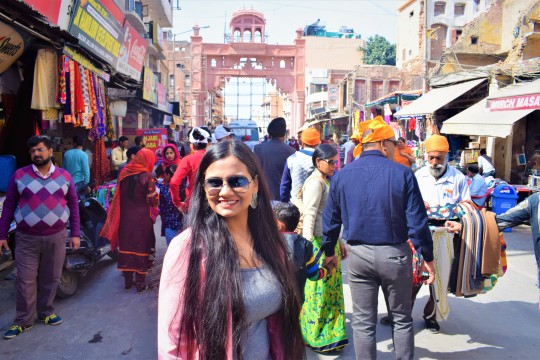
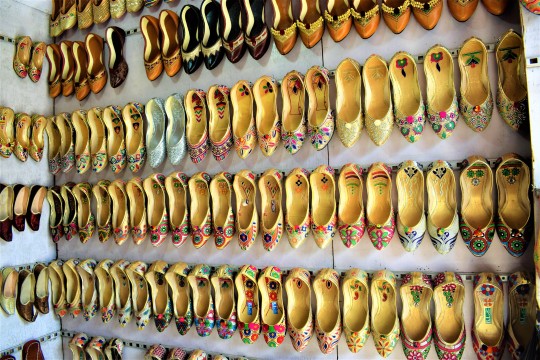

At about 2 pm I finally left the Golden Temple after spending over 6 hours here.
I hope I’ll be back one day.
After leaving from The Great Golden Temple, the nearby place is “The Jallianwala Bagh”. We’ll write another post for the great memory of this sad event.
So Friends this is another destination, make sure you backpack soon for this place on nearby future. And there must be so many friends who have already visited this place, do let me know if my words did justice to this wonderful destination!!
��Do not forget to write me your stories for the destination”
Your’s
Richa Gujaria.
2 notes
·
View notes
Text
Khanpur Dam
Khanpur Dam is a dam located on the Haro River near Potowar Plateau and the village of Khanpur, Khyber Pakhtunkhwa, Pakistan, about 25 miles (40 km) from Islamabad, Pakistan. It caters to domestic water supplies in Rawalpindi and Islamabad, and irrigation water to many of the agricultural and industrial areas surrounding the cities.
The dam was completed in 1983 after a 15-year construction period believed to have cost Rs. 1,352 million. It is 167 feet (51 m) high and stores 110,000 acre feet (140,000,000 m3) of water. The adjoining Khanpur Lake is the venue for Sarhad Tourism Corporation's annual airborne and waterborne sports gala. The event, termed as the 'biggest' in Pakistan was scheduled to take place between 9 and 11 April 2010.
History
The dam was built by Ayub Khan, former President of Pakistan. The dam was believed by many to be a way for Khan to settle political scores with the feudal chief of Gakhars Raja Erij Zaman Khan.
The forefathers of local Gakhars Rajas were given much of the local land by the British during the nineteenth century. The British rewarded the Gakhhars for their cooperation in defeating the Sikhs, but deprived the local Awan and other farmers of their land. When the decision to build Khanpur Dam was made, the Rajas wanted to receive compensation for all the land, thus depriving all the local inhabitants of their land rights. The residents desperately wanted to receive compensation or new land in the nearby New Khanpur.
The local community, led by Abdul Bashir Khan (the father of Saeed Khan), the young secretary of Khanpur’s WAPDA Union in the early 1970s, took on the Ghakhars and their friends in the Khyber Pakhtoon Khoa parliament. Amid threats and intimidation, the campaign succeeded in uniting most local villagers, who had nothing but their land. Abdul Bashir and his fellow activists decided to take their campaign straight to then Khyber Pakhtunkhwa governor Hayat Sherpao by camping outside the governor's house for days. Abdul Bashir and his fellow activists left Peshawar only after they had succeeded in winning the land rights for the people of Khanpur.
The locals were promised free water and electricity by WAPDA and the then provincial and federal governments, but are still waiting to this day
#Sarhad Tourism Corporation#Pakistan#Khyber Pakhtunkhwa#Khanpur Dam#Islamabad#Hayat Sherpao#Haro River#Ayub Khan
0 notes
Text
Four dead bodies with bullet in head found in Ghotki
Four dead bodies with bullet in head found in Ghotki
GHOTKI: Four dead bodies with bullet wounds in heads found in Sarhad police station jurisdiction in Ghotki district of Sindh, ARY News reported on Wednesday.
Local people found four dead bodies under a National Highway bridge at Saleemabad village near Sarhad Umar Daho. The people informed the police about the dead bodies, however, the police reached to the crime scene late, local sources said.
View On WordPress
0 notes
Text
Day 10
After a good night’s rest, we enjoyed a hearty breakfast at the resort, excited to start the new day’s activities. We were especially reluctant to leave this beautiful resort and took the time to take a few group photos.
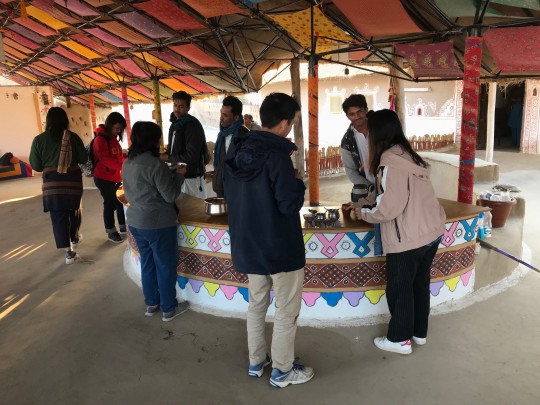
Breakfast at Shaam-E-Sarhad village resort at Bhuj.
After an hour’s bus ride, we met Mr Gaurav from Arid Communities and Technologies (ACT).
Mr Gaurav gave us a comprehensive overview of the geography of Bhuj, in terms of its existing water catchment areas. We learnt that the kings of the past had the wisdom and knowledge to plan out and build man-made catchments in strategic areas that linked up with natural catchments to ensure that enough water is collected and stored for use, in spite of the highly irregular and infrequent rainfall. The past year had 30-40mm of rainfall compared to the usual 300-400mm!
Mr Gaurav then brought us to the ridgeline, the highest point of Bhuj, where we were greeted with a vast and majestic landscape!

The view from the top of the ridge line.
We learnt that the ridgeline is the line that divides a region into 2 watersheds. Many of us were glad to have the chance to revisit the knowledge gained in our past geography lessons.
Up the hill, there was a particularly steep and slippery portion where we took turns to help each other up. This was one of the many instances where we looked out for each other on this trip and offered help when it was needed. Other examples include sharing water, snacks and paying for each other when we didn’t have enough small change.
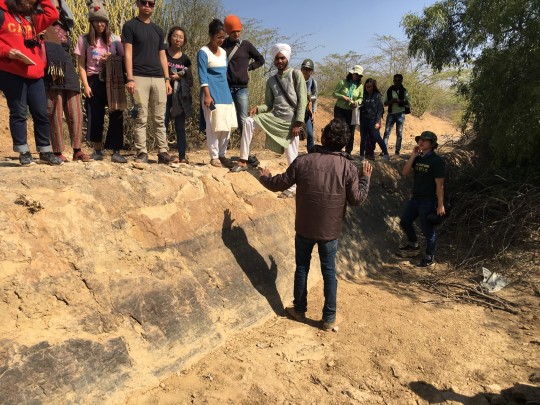
Fault line.
We proceeded to visit a fault line that was visible from the surface. The side where most of us were standing on is mostly made of sandstone while the other side consist of mostly clayey soil. Clayey soil does not allow percolation as it is non-porous, which meant that the groundwater within does not get recharged and its levels dropped drastically.
Next, Mr Gaurav brought us to a solitary 80 foot well. We were told that the past kings built this along the sandstone side of the fault line as they knew about the non-porous properties of the clayey soil and how it will not contain much groundwater in the long run. This is further evidence of the great foresight of the past kings and their advisors, as they didn’t just plan for the next 5 years, but for the next 500 years.
Mr Gaurav shared how the water scarcity situation in Bhuj has worsened over the years as recent building construction on lakes has disrupted the groundwater recharging process. As a result, the number of lakes in Bhuj has reduced drastically and the quality of the remaining lakes have deteriorated.
Mr Gaurav also shared how the organisation tries to educate the public in layman terms on how the existing self-sustaining water catchment system in Bhuj has been successful for the past 475 years and the importance of maintaining this system in order to reduce the reliance on water from external states. We were glad to gain insights into the community participatory approach that ACT implemented in order to address the issue of water scarcity.

Presenting our token of appreciation.
While we did not manage to view the Hamirsar lake (the largest catchment area) due to lack of time, we were still extremely grateful for Mr Gaurav’s patient explanation and interesting tour.
We were in a rush against time in a bid to reach our next stop, Bhuj train station, in time to catch the train. Our lecturers thoughtfully ordered packed food to consume on the train to save time and they turned out to be delicious! However, the servings were huge which proved a challenge to finish for many.

Our train cabin.
The cabins were cozy and we were happy to find out that each of us were entitled to a bed! Some of us took the opportunity to get some shut-eye during the 4 hour train ride, while the rest of us took the time to share life stories and catch up on their dramas and tv-series. In particular, a few students were lucky to get to interact with some of the other locals travelling on the train. Overall it was an extremely comfortable and enjoyable journey.

Taking a much-needed rest.
We had some time to spare when we reached Surendranagar and unanimously decided to explore the area around the station. We were pleasantly surprised to encounter a few pigs (or wild boars) roaming around the village, which was a rare sight that most of us don’t get to see in Singapore.
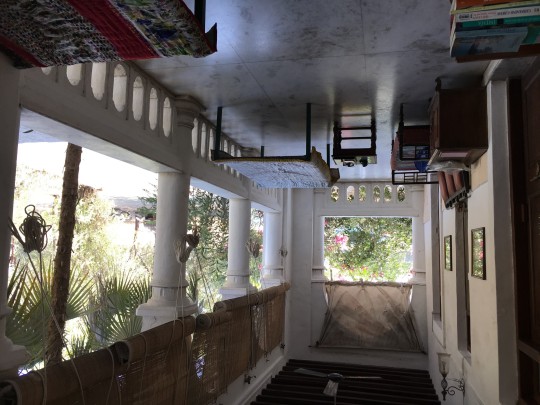
The veranda at the Bell Guest House.
We then returned to the bus and after an hour’s ride, we reached our accommodation for the next two nights, the Bell guest house. We found out that the guest house is an indo-european building with a rich history that belongs to the Sayla royal family. The owner, a descendant of the Sayla royal family, shared with us that the building is actually 150 years old!
Thereafter, we had dinner provided by the accommodation. Many of us particularly enjoyed the rendang chicken, pasta and tomato soup. Indeed, it was a feast befitting of a king! Following the scrumptious dinner at 10+ pm, we all took advantage of the hot water to bathe and had an early night after our long day of learning and travelling.
Timothy & Jia Jin
0 notes
Text
Insight into Rann Utsav at Great Rann of Kutch
When it comes to counting colors, moods, moments & occasions, no alternative place in India, if not the globe, is additional versatile than Gujarat. Blessed with rare geographical diversity & rich flora & fauna, Gujarat additionally attracts tourists for its ethnic, colourful folks.
There are some things in life as colourful because the desert- hidden in this barren land may be a riot of colors, reflecting in the folks who live there. A highlight to the present is the tribal community of the hauntingly stunning Rann of Kutch, that is still committed to tradition, rituals, and customs & after all, Festivals. Here is my attempt at familiarizing the intrepid traveler with one of Gujarat's Biggest & most standard honest-festival: The Rann Utsav. This festive extravaganza is the best tribute to the sweetness & spirit of this glorious region that's known for enveloping the state in a frenzy that may put the most effective vocabulary to shame.
A unique geographical feature of Kutch is the Great Rann of Kutch, an expanse of concerning 30,00zero sq km of salt desert & seasonal marshland that lies between the Gulf of Kutch & the Indus River. The area was once the shallows of the Arabian Ocean before geological uplift closed off the association of the sea, let alone an enormous lake which turns into a desert.
The Rann Utsav, an annual competition, offers an unimaginable chance to explore the Great Rann of Kutch & the Banni grassland to the north of Bhuj. In December-January, an enormous tented village near Dhorodo village is founded by the Gujarat tourist authorities to accommodate tourists for the festival. Because the evening shadows lengthen, camel carts are readied to take tourists into the salt flats & marshes of the Great Rann of Kutch. You'll be able to witness the sensible sunset from the camel carts. After disembarking, trudge on the salt flats to relish a excellent read of the white desert shimmering in the moonlight. The atmosphere is especially breathtaking on a full moon night. Food is served within the desert wilderness & musicians sing folk songs of the region, known for its Sindhi 'bhajans' & Sufi music.
Another distinctive expertise of the Rann Utsav is that the trip to Kala Dungar, literally Black Hills, of Kutch. The drive lands up the hill to the Dattatray Temple which incorporates a singularly lovely view of the vast expanses of the salt desert of the Great Rann of Kutch stretching towards the India-Pakistanborder. The surrounding scrub vegetation trills with the decision of birds. When the priests of the temple decision, 'Lo-Aang', packs of jackals come back out from the scrubland to feast on the temple offerings laid out for them.
Dhorodo lies in the heart of the Banni grassland where pastoral villages turn out some of india's finest hand-embroidery with a selection of styles that differ from one community to another. You'll be able to tour the gamut of villages that dot the grasslands like Sumrasar Sheikh, Bhirendiaro, Hodka, Gorewali, Dhorodo, Ludia, etc. to observe women doing embroidery. You'll be able to keep at Shaam-e-Sarhad, an endogenous tourism resort in Hodka designed using local craft skills.
Northwest of Bhuj, the villages of Zura & Nirona are home to several lesser known craft skills. At both these places, it is doable to observe 'luhar' (blacksmiths) hand-casting melodic bells. These villages are also known for his or her lacquered woodcrafts. The people art that's currently restricted to only one family is 'rogan', which involves an intricate method of creating colours by mixing pigments with castor oils. Southwest from Bhuj, Mundra is that the centre for 'namada', the art of felting. Dhamadka may be a traditional centre for 'ajrakh' block-printing. For daring embroidery of the Ahir community, visit the villages of Dhaneti & Padhhar.
In conjunction with craft villages & the distinctive salt desert landscape of the Great Rann of Kutch, the Rann & its adjacent Banni grasslands are pleasant for bird watching. Flocks of flamingos & storks mingle concerning the pristine fresh-water lakes & salt marshes, together with a sensible number of larks, eagles, falcons & alternative raptors.
A visit to Bhuj is an expertise of its types. Though the 2001 earthquake devastated Bhuj & destroyed its grand palaces, it's still one amongst the simplest places to get an introduction to Kutch with fine monuments, museums & markets.
Tera at Kutch could be a heritage village with a scattering of mosques, temples, stepwells, havellis & a medieval fort with Ramayan-themed frescoes within. A notable feature of Tera's havelis is the gateway- carved wooden doors framed by ornate stonework that includes Indian & western motifs.
The north western tip of Kutch, with its fortified villages, was once an necessary centre for sea trade & the villages here grew prosperous from the maritime activities.
The pageant additionally features folk performances, competitions & handicraft demonstrations. Choose from excursions organised to varied sites, from the archaeological website at Dholavira to the holy lake of Narayan Sarovar.
0 notes
Text
Delhi-Lahore bus meets accident in Fatehgarh Sahib, all passengers safe
Delhi-Lahore bus meets accident in Fatehgarh Sahib, all passengers safe
Patiala, June 20
The ‘Sada-e-Sarhad’ bus, which runs between India and Pakistan, met with an accident near Jahankhela village in Fatehgarh Sahib on the GT Road on Tuesday, police said.
Police said due to rain the road was wet and when the driver applied breaks the bus skidded, hitting the escort vehicle.
The policemen, who were sitting in the escort vehicle, received minor injuries. They were…
View On WordPress
0 notes
Text
30 Photos From Afghanistan That You Won’t See In The News
Traveling in Afghanistan
Afghanistan
Last summer I traveled into the mountains of Afghanistan for a two week backpacking adventure. Not your typical summer vacation destination. Here’s what I witnessed on my journey.
What comes to mind when you think about Afghanistan? War? Terrorism? Osama Bin Laden? The Mother Of All Bombs?
Sure, much of Afghanistan is still dangerous — but there’s also incredible beauty, hospitality and kindness in the country that doesn’t get reported on.
It’s far too easy to vilify or write-off an entire nation when you don’t have to look those people in the eyes. People with the same hopes and dreams as you — to survive, find happiness, and provide for their families.
I was able to experience the positive side of Afghanistan and its wonderful people, up close and personal, during my trip there last summer. It’s since become my most memorable travel adventure to date.
Here are some of my favorite photos of people & landscapes from my 100 mile trek into Afghanistan’s remote and mountainous Wakhan Corridor.
This is the “other” side of Afghanistan that you don’t see in the news.
The Hindu Kush Mountains
Traveling in the Wakhan
Wakhan Corridor
The Wakhan is a rugged and wild region of Northeast Afghanistan, part of Badakhshan Province. It’s a narrow peice of land, about 400 km long, surrounded on three sides by Tajikistan, China, and Pakistan.
Two large mountain ranges dominate the area, the Pamir in the North, and the Hindu Kush in the South. The Wakhan Corridor was created by politicians in the 1800’s during the “Great Game” in an attempt to leave a buffer zone between British India and the Russian empire.
Riding Yaks in the Wakhan
Hitchhiking By Yak
Taking a break from walking, I managed to hitch a ride on a yak for a portion of the route. We ran into a group of Wakhi men leading their yaks through the mountains. While they stopped for tea, they let us borrow their yaks, which we led further into the valley until their owners caught up with us later.
Yaks are the ultimate eco-friendly 4×4 in Afghanistan, able to climb steep rocky terrain and power through icy cold rivers. There are no trees above 10,000 feet, so locals are forced to trek for 3 days to lower elevations with their animals in order to gather firewood for cooking and warmth.
Ruined Stone Shelter on a Vast Landscape
Trekking in the Wakhan
Ancient Silk Road
The Wakhan was once part of the ancient silk road, an important trading route connecting China to Europe. Along with silk, horses, and other goods, it was a highway for armies and explorers too. Explorers like Marco Polo who is believed to have passed through here during the 13th century.
Crossing steep mountain passes and high desolate plateaus, passing caravans of yaks and donkeys loaded with goods, spending the night in stone shelters with traveling merchants — I felt like I was getting a glimpse of what the silk road must have been like all those years ago.
Muslim Shopkeepers in Afghanistan
My Compatriots in the Wakhan
The Many Faces Of Islam
Just like the many different branches of Christianity, there are many different branches of Islam, all with their own beliefs and values. Many people living in Afghanistan’s Wakhan Corridor are Ismaili Muslims, who practice a moderate form of Islam. They number 25 million worldwide, and despise the Taliban.
Their spiritual leader is the Aga Khan, a successful British businessman and Imam who runs the Aga Khan Development Network, a super important charity organization that improves living conditions and opportunities for the poor in Africa and Central Asia.
Footbridge Over the Wakhan River
Untamed Blue Rivers
The Wakhan River runs through the Wakhan Corridor, fed by the high altitude mountains of the Hindu Kush on the border with Pakistan. It snakes its way through the mountains, and is a major lifeline for the people living in this harsh and unforgiving landscape.
The bright blue color of this water is due to reddish hues of the rock formations around it, as well as the crystal clear source (a glacier). Water molecules absorb other colors, like red, more efficiently than blue.
Enjoying the Wild Landscape
Snowy Mountains in August
Epic Mountain Views
When the weather was clear, I was rewarded with incredible views of the mountains like this! The trail was well worn, as it’s used daily by small groups of locals who travel in caravans of yaks or donkeys from settlement to settlement.
The 10 day trek ranged in altitude from 10,000 to 16,000 feet, and we averaged about 10 miles per day of hiking. I began to feel the effects of altitude on my body around 12,000 feet with shortness of breath. At 16,000 feet hiking became even more tiring and difficult.
Snow Covered Yurts
Kyrgyz Settlement in the Wakhan
Portable Yurts
The Kyrgyz people of Afghanistan are semi-nomadic, moving from valley to valley herding their animals to different grazing pastures depending on the season. They live in cozy yurts made of sheep felt, which can be broken down and transported long distances.
Each settlement consists of 2-3 families living and working together. Originally from the area around Kyrgyzstan, their ancestors were kind of trapped in the Wakhan after the Soviets took over Central Asia, forcibly settled nomadic tribes, and sealed off the silk road route.
Sheer Chai Milk Tea
Salty Milk Tea
Both the Wakhi and Kyrgyz people drink large amounts of salty milk tea, called Sheer Chai. It’s served for breakfast, lunch, and dinner. Basically, it’s a mix of yak and goat milk, boiled down for hours and dried into a portable block. It’s prepared by adding boiling water, loose-leaf tea, and rock salt.
The salt is great for rehydration at high & dry altitudes — I called it my Afghan Gatorade. It took a while to get used to (salty hot milk anyone?), but by the end of the adventure my body was craving sheer chai for every meal. You can also dissolve raw butter into the tea at breakfast for extra calories.
Petroglyphs in Afghanistan
Afghan Petroglyphs
Near the end of my 2nd day on the trail, we hiked past a set of ancient petroglyphs scrawled into a dark colored boulder overlooking the valley. My local guide, Yar, couldn’t tell me much about them, other than they think these markings are a few thousand years old.
They depict hunting scenes, men armed with what appear to be bows, as well as large game like ibex and the rare Marco Polo sheep. This was just one of many petroglyphs that dot the landscape in these mountains. They are thought to mark ancient hunting grounds claimed by different tribes.
Central Asia Institute School
Kyrgyz Boys Ready for Class
CAI Schools
This simple 3 room school in the remote Afghan village of Bozai Gumbaz was built by Greg Mortenson and his Central Asia Institute. You may have heard of Greg before, he’s the author of the best selling novel Three Cups Of Tea, about building schools for girls in Pakistan.
The school at Bozai Gumbaz, where I spent the night playing cards with Afghan army soldiers, was prominent in his 2nd book, Stones To Schools. The next morning a group of boys showed up on donkeys for class. I saw many CAI schools along the road from Eshkashim to Sarhad-e Broghil.
Camping in Afghanistan
Camping In Afghanistan
As a big fan of the outdoors, one of the highlights on this trip was the opportunity to wild camp in the mountains of Afghanistan. Most nights we were able to stay at small Wakhi or Kyrgyz settlements in basic guest huts, but we also camped out in tents a few nights too.
Normally I’m a camping hammock kind of guy, but because I knew there weren’t going to be any trees for most of this trek, I packed my super lightweight Nemo Hornet 2P Tent. It snowed a few times during the journey — in August!
Greetings From the Heart
Friendly Shopkeeper in Eshkashim
As-Salāmu ʿAlaykum
I was constantly greeted with As-salāmu ʿalaykum which means “peace be upon you”. A shorter version of this is just salām. Shaking hands is common, and so is placing your hand on your heart, which simply means your greeting comes from the heart.
Another important term I used during my journey is taschakor, meaning thank you. I always recommend trying to learn 10 of the most used words in a local language before traveling there. In the Afghan Wakhan, most people speak some Dari (Farsi) along with local dialects.
Afghan Woman Wearing Blue Burka
Wakhi Girl in Sarhad-e Broghil
Women In Afghanistan
Many people were asking if I saw women in Afghanistan. Yes I saw women during my trip, but most were extremely shy, especially if I had my camera out. Plus in their culture, talking with strange men is taboo. But shooting portraits of men or kids was not a problem.
Near the border town of Sultan Eshkashim, which is primarily Sunni Muslim, many women wear the full-length blue burqa that covers their face. In more rural areas of the Wakhan, it’s less strict. Women wear long colorful dresses with a simple headscarf. I was able to say hello and see their faces.
Kyrgyz Tombs at Bozai Gumbaz
Khajahbigali Family Tomb
Shrines & Tombs
I encountered a few ancient burial tombs during my time exploring the Wakhan Corridor. Near the Afghan military outpost of Bozai Gumbaz, there’s a collection of strangely shaped Kyrgyz beehive tombs, along with evidence of Soviet bombing (craters, bomb fragments) from the 1980’s occupation.
At the settlement of Langar, we found a pile of ibex horns marking the burial place of a powerful big man. In Afghanistan, wealthy & powerful men are often called “big men”. It’s a bit like calling someone “boss.” The more animals, land, and wives you have, the “bigger” & more influential you are.
Driving in Afghanistan
Rough Roads
Before I began the 10 day, 100 mile trek through the mountains, I had to hire a 4×4 van to drive me to the last village at the end of the road. We passed a few military checkpoints along the way, stopping for tea & candy with officials before continuing on.
The drive took 2 days, and the roads were some of the worst I’ve ever seen. Dust seeped into the vehicle, covering us in dirt. We forded rivers, drove along the edge of sheer cliffs, and were frequently stopped by huge herds of goats blocking the road. The van suffered 6 flat tires during the journey.
Cooking Lunch in a Stone Shelter
Wakhi Settlement
Wakhi Settlements
While I entered Afghanistan alone, I decided to hire a local translator/guide and horseman to accompany me on the trek into the mountains. It would have been extremely difficult to communicate with people without their help. We spent the night at a few Wakhi settlements during the hike.
Wakhi homes are basically stone huts with dirt floors, constructed using manure for cement. The roof is made of logs, grass, and more manure to keep it waterproof. Some shelters had stoves inside, others just had a fire pit. Either way it was pretty smoky…
Young Afghan Girl in Sarhad
Wakhi Family Living in the Mountains
Children Of The Wakhan
Life in the Wakhan is rough, especially for kids. About 60% of children here die before the age of five, the highest infant mortality rate in the world. If they do survive, they are put to work helping out with the family business — animal herding.
There are a few schools out here, thanks to the Central Asia Institute, but it’s up to the parents if they go. In some communities, only the boys are sent to school. The morning commute can take a few hours by donkey due to the lack of roads and distance between settlements.
Central Asian Bactrian Camel
Wildlife In Afghanistan
I was really hoping to see a snow leopard or Marco Polo sheep while I was traveling through the mountains of Afghanistan’s Wakhan Corridor. You know, Walter Mitty style! Unfortunately both of these endangered animals are extremely difficult to spot — but I did find camels!
Luckily the Wildlife Conservation Society has staff in the area, often spending weeks in the field gathering data to protect wildlife in the Wakhan. They estimate there are about 100-200 snow leopards living in these mountains. Wolves and bears also call this wilderness home.
The Country You Thought You Knew…
The Other Afghanistan
So there you go. A peek at the other side of Afghanistan that we never see on the nightly news. After traveling the world extensively for the past 6 years, I’ve noticed this is a common theme.
Don’t let our media, which is primarily focused on negative & sensational topics, be your only window into the dynamics of a foreign country you’ve never been to.
I’m not going to tell you that Afghanistan is safe. It’s not. Our troops who’ve served there can tell you. Afghans themselves are well aware of the dangers that plague their country too.
But I think there’s another side to Afghanistan that deserves some attention. The rugged, scenic mountain landscapes. The friendly, hospitable local people.
I’m hopeful for the day when Afghanistan’s problems fade away, and more travelers can safely enjoy the beauty this incredible country has to offer. ★
Bonus Video! Backpacking Afghanistan
Subscribe to my YouTube Channel for new Adventure Travel Videos!
(Click to watch Backpacking Afghanistan – Wakhan Corridor on YouTube)
Pin This On Pinterest:
READ MORE FROM AFGHANISTAN
How To Visit The Wakhan Corridor
Have any questions about Afghanistan? What do you think? Drop me a message in the comments below!
This is a post from The Expert Vagabond adventure blog.
0 notes
Photo

Matthieu Paley shooting video on the Wakhan river.. Leaving Sarhad village (end of the road in the Wakhan Corridor), to trek up to the Little Pamir with yak caravan over the frozen Wakhan river.
17 notes
·
View notes